THIS BLOG IS NOW CLOSED.
Why Kris is amazing
I look that smart every day really, even at school where I am currently studying media.
I love film and taking pictures, and if you scroll down the page you will see some random examples of this I have managed to dig up..
Anyway, on here I will be posting all my AS media foundation portfolio work and basically it will be pretty amazing...
Sunday, February 1, 2009
Friday, January 30, 2009
- The prelim brief - very specific, focus on certain continuity techniques, film a particular scene, had to include dialogue and exchange between two characters, simple, time limit of three hours.
- The main brief - room for creativity and originality, focus on all aspects of film, film an opening sequence of a film, had to include opening sequence conventions and chosen genre conventions, had whole course to film until deadline day (about two months), had to be two minutes.
What our group learnt from the way we took on the prelim brief:
- We knew we had to keep things very simple as even simple things take a long time in the film world (the whole process).
- We had to work quickly as we had a lot more to organise (actors, location, film plot).
- We did not book our location properly in the prelim and had trouble with people walking in and out of the room we were using to shoot, so we knew we had to nail down the location first and base everything else around it.
- We had to simply adapt around what we had and make use of all available resources.
- We had to communicate well as people got stressed out with each other in the limited time the prelim task gave us, because they were not communicating.
- We had a genre and audience to think about the whole time, so things were going to be different.
What we learnt from the prelim planning process:
- We were taught to write a basic script, draw a storyboard, write a shot list and then draw a shot script from the shot list, which gave us an order to shoot shots in. This helped immensely on shoot as it sped up the process and was a huge part of good organisation. We would not have thought of using a detailed storyboard and shot script on our main task if it were not for the prelim task.
- We were able to split roles between us (one on drawing, one on writing, one on script etc) during the prelim so we applied this to our main task (one on location/props/actors, one on narrative/plot/characters and one on organisation/bookings/to-do-lists/blogging). There were more roles to fill but we got through these quickly by good role organisation.
- We used a location 'reccie' (short for reconnoitre) in our prelim to get a feel for our location and test out suitable angles before the test shoot. Therefore planning for the test shoot was easier. We also used this method in our main task and it gave us knowledge of our location such as the fact we had to move so many boxes to clear the space we wanted to use.
However, there was alot more to organise for our main task (props, actors, lighting etc) and therefore there was alot more to research other than just continuity in our prelim task. It provided us with a greater challenge, but the prelim task had provided us with the basics to give us a head start and organised state of mind.
Things we learnt from the prelim production process:
- We knew beforehand how to use the equipment (apart from lights) such as the Canon cameras and on-board mics. We were given inductions before our prelim task and after the prelim we were thoroughly confident in what we were using.
- We were aware of all the things that could go wrong with a shoot, which happened in the prelim task. This involved continuity issues, time-wasting, shots not looking right that we thought might work, and not getting enough shots. We learnt to always take more than one take of each shot, to try and get as many angles of each shot (whether they look bad or not) and to improvise on the spot to add different perspective to shots that did not look right. We were also made aware of how time could fly by, as we nearly ran out of time in the prelim task and ended up rushing shots, hence not getting enough to edit with.
- We were made aware of continuity issues having learnt the continuity techniques of shot/reverse shot, master shots, 180-degree rule and match on actions. Our prelim task brought out basic mistakes in match on action when we took a shot of a computer screen, but from the shot before the website had changed on screen. We were taught how to check every little thing was in place, especially when re-shooting in the main task, so that there were no continuity errors. This was all to achieve a seemless narrative.
- We learnt how to swap roles between us all on shoot (director, assistant director and sound director) during the prelim task and we applied this to the main task (swapping between director, assistant director, sound and lighting).
- It took us a long time to set up for our prelim shoot (about 15 minutes at the beginning of the shooting hour was spent setting up the tripod). Therefore for the main task we opted to book one long 4 hour shoot instead of lots of short shoots, to minimise time wasted setting up, and to not break our focus once were in 'shot mode'.
- We were encouraged on our main shoot to tell actors to leave more pauses between sentences as on our prelim task the conversation was too quick ending in editing problems - dialogue cut together too quickly resulted in quick-fire shot/reverse shots that looked silly and over-dramatic.
- We learnt not to rush things as many shots for our prelim task were messy with cutting points. We had to precise and for our main task we were backed up with a re-shoot.
There were some differences. For our main task we had to think about our actors, treat them well and look after them. We also had a test shoot before our main shoot to get ourselves together as we had far more to think about. We did not focus on getting everything done in our actual shoot but set ourselves little targets to achieve at a steady pace.
Things we learnt from the prelim editing process:
- We learnt how to use simple editing techniques on Adobe Premiere Pro such as the razor tool, cutting and re-ordering clips to achieve good continuity. This gave us the basics to fall upon in our main task and we could progress in more complex techniques from that starting point.
- Due to limited time in our prelim task we captured one big clip of our whole shoot and cut and dragged shots straight onto the timeline from there. It got quite confusing and time was wasted searching through the whole shoot trying to find where we shot a particular shot. For our main task we split up the clips and organised them into bins, named. Therefore we did not waste time looking for particular clips as we just had to find the labelled clip we wanted from the particular section we wanted (i.e. a bin called 'conversation shots' or 'cutaways').
- In the prelim task we split up the hour we had into 15 minutes each on the mouse editing (there were four of us) but we all still had imput. This taught us the patience to help others edit without taking over the mouse, and we carried this into our main task, all of us getting our fair share of editing time. This caused no arguments or hard feelings.
- The continuity aspect of the task made us hungry for perfection (spending long amounts of time on tiny little things such as sound levels), which we carried forward into the main task. We spent days and days on very small aspects of our film just to achieve perfection.
However, for our main task we had to think of ways to appeal to our audience through subtle enigmas, filmic picture and effects, using new software (After Effects) to aid our titles, and adding music and sound effects from the internet to add to atmosphere (which the prelim task lacked). We also concentrated more on the image, changing contrast, saturation and brightness to give a cinematic look. There was more than one focus whereas our prelim task was simply about the editing. Once again the prelim task gave us the basic foundation of editing but the main task challenged us to expand our editing skills from this point.
Things we learnt from the prelim evaluation process:
- The prelim evaluation has given me something to look back upon during this evaluation, causing me to remember to think about the problems we faced and how we resolved them, other than just what we did on the task. I remembered to talk about things I would do differently because of my preliminary exercise evaluation (see relevant blog post).
- I learnt the basic analytical mind-set during the prelim reflections task and evaluation.
- I learnt how valuable audience feedback is, as we recieved some from other classmates when showing our sequences in a lesson. The criticisms gave me alot to think and talk about during my evaluation, so for our main task we held a big audience screening (more relevant to our target audience) and summarised our feedback to help us see problems in our sequence - for analytical purposes.
- We learnt to look back at what we had learnt relative to the task, which for the prelim task meant continuity theory, but for the main task meant everything (theory on audience, genre, narrative, moving image etc).
However, I found this evaluation alot harder to string together than the prelim one. For this evaluation we had to think about the whole picture and the films relationship with the audience. There was so much to talk about that we decided to have a group discussion to discuss the most important points we would bring up. We also wrote drafts of our evaluation on which I wrote alot more than I should have, and our teachers marked them and told us what to cut out and what to improve on. Furthermore, there was alot more audience feedback to include (30 questionnaires worth compared to 10 or so classmates for the prelim task).
All in all, I think we did learn from most of our mistakes because of the prelim task where we were taught the whole process, an organisational and focused mindset and a hunger for perfection. There were still some issues we found hard to overcome such as continuity issues, mainly to do with moving all the clutter (including many boxes) for both shoot and re-shoot, and keeping chains in the same place. However, we were definately more organised and prepared for most problems we were faced with. We had realised the importance of the little things such as the shot script and how to solve problems and improvise - something we had to do when faced with new problems during our main shoot. These certain issues the prelim task did not prepare us for such as winter illness, actor reliance and lighting problems. On the other hand, I do not think we could have created such a fantastic sequence (and one that I am very proud of) if it were not for doing the prelim task beforehand as it prepared us for the whole process of constructing a film - a process that is long and hard but worth it for the end product.
"What have you learnt about technologies from the process of constructing this product?"
The first thing I learnt was how to blog using http://www.blogger.com/, which I believe is a much better way of displaying portfolio than folders/files or Powerpoints as it is quicker, easier to display things such as photos and videos and it is easy to link to other websites in order to explain fully what you mean.
I have a list of hardware and software we used which I will refer back to in this post (see pre-evaluation summary).
Things I learnt whilst shooting:
- I learnt how to use our Canon mini-DV HD cameras and its basic features such as setting it up with battery and tape, the zoom button and recording (we did not use HD tapes because they are expensive and would slow down our school computers, which have not yet been updated with correct HD settings). We learnt how to run the camera on batteries, not mains, so it was versatile with the tripod and we could shoot handheld shots.
- I learnt how to play the roles of director, assistant director and sound director. As director we were told to ask, "Sound? Camera rolling... and, action!" and we were taught to run the camera for a couple of seconds either side of the action to make it easy to edit and not miss any action. Assistant director held up the clipboard with scene number and take number and sound director got to wear the headphones to hear what the on-board mics were recording. It was all very efficient.
- I learnt how to use studio lights (we used three) with barn doors to gain lighting in all different kinds of angles. We also used blue gel clipped to the front of the lights for our blue effect and a white throw in the background to cover much of the clutter in the scene. We learnt that the lights were very versatile and great to gain extreme varities in light intensity and in colour using different coloured gels. However, they were a hassle to keep having to set up and pack away, and it took them a long time to cool down after using them for a few minutes - this led to an accident on shoot (a burn and smashed light filter). They have to be handled very carefully and the group must take full responcibility in looking after them and themselves.
[Pictures on test shoot: top left - high intensity lighting / top right - video camera use / middle left - use of orange gel on lights / middle right - use of blue gel on lights / bottom left - the camera & lights set up / bottom right - low key lighting.]
- I learnt the basic processes of using Adobe Premiere Pro to edit, which included non-linear editing. It gave use the chance to switch between different sequences and timelines. We had a practise timeline in which we pieced together random strings of shots that we thought might look good in our actual sequence. The ones we liked we copied and pasted into our real timeline. We also used another sequence to cut together some outtakes. It was very easy to do all these things in one project and mistakes were easily undone, so there was no pressure - we could relax whilst experimenting.
- I learnt some new processes I had not come across before in this particular editing software (which we have used for a previous project). I learnt how to layer shots, vary speed and duration of shots, vary volume and sound levels using markers, ghosting using the cross-dissolve transition, transferring files between PC and Mac, and frame by frame editing in Paintshop Pro (to eradicate a schoolbag in the background of a scene). I was used to these processes by the end of the project and from now on I am probably ready to move on to more advanced settings.
- I learnt how to use Adobe After Effects (another part of the Adobe creative suites - CS's) to make our titles special. This was done by editing each individual letter for our title seperately and putting a glowing/fade in effect on it, whilst also setting markers on transparency to make them flicker. We put an order to when each letter faded in and put them all together as one animation in which random letters came in at different times to spell 'Reservation'. From now on I will probably use the programme to create titles. Other programmes I briefly used were Livetype and Handbrake on iMac, Livetype had built in animations that we never used because they were not what we were looking for, and Handbrake we used to enhance our scream sound at the end by mixing it with a sound ripped from a DVD, which did work in the end. It was Jack who used this programme more so I did not learnt how to use it properly.
[Picture - our edit suite.]

- We agreed more should be taught about using the manual settings on the Canon video cameras as we had a problem with blur during inconsistent lighting (our flickering lights kept making the lense re-focus and therefore blur for a couple of seconds). My brother informed me there was a way of adjusting the lense settings so that the focus did not automatically adjust to changes in lighting, and therefore would not move in and out of focus on flickering lights - we did not know how to do this and still don't, but the method is supposed to be simple so could be something we learn early on this course.
- We thought there could be more lessons on using the lighting equipment as only two groups (including ours) got to use the studio lights and we had to be assisted alot by the media technition in handling them. We thought more could be made use of out of the focus settings on the lights for more filmic effects and to adapt to different surroundings. In the end this was not a problem as our lighting was OK, but it is something we thought we might need to know on future shoots.
Wednesday, January 28, 2009
We addressed our audience by giving them an opening sequence with farmilar forms to others and addressed the horror fans by using horror conventions. We attracted them by getting in touch with their feelings and filling the film with unique attributes.
The opening sequence conventions are mentioned on Question 1 but I will outline them here:
- Consistent credits with a main title at the end.
- Clear location and setting (establishing shots of the basement and good mis-en-scene).
- Introduction of characters (a minute of dialogue and interaction between them to get a feel for their relationship and personalities).
- Good continuity by use of shot/reverse shot and the 180 degree rule continued throughout the conversation scene. Also, the use of matched on actions such as the killer putting the victim to sleep with the cloth before pulling his arm away in the next shot as he turns to leave the victim sleeping (1.40 mins). This prevented distraction from the film because of lack of flow in the continued story.
- Use of enigma codes to get the audience to interact and fall into the film world.
The first thing we did to appeal to our audience was chose a popular genre with our core audience of 18-25's, and we thought horror was extremely popular, especially the 'Saw' and 'Hostel' films. Therefore we had to conform to their expectations by making our horror similar to that of the 'Saw' films.
My favourite aspect of the openings to 'Saw' was the variety in pace. It began very steadily, holding back lots of information and the actual appearance of the characters. Instead it focused on miscellaneous objects such as walls, pipes and bulbs, and the characters tied up were revealed bit by bit, with CU's of feet, eyes and mouth, before the shots moved further away from the character. It was 30-40 seconds before the actual character and location was revealed. We tried to achieve this affect in our film with opening credits appearing alongside random objects, helping establish the basement atmosphere, and a confusing montage of the victims face waking up to give a dazed effect. There was not an establishing LS until 33 seconds in, which helped lure the audience. Like 'Saw' the film did not pick up unnecessary pace and continued steadily through the dialogue. [The following compare 'Saw' on the left to 'Reservation' on the right, comparing first victim CU and then lightbulb shots].
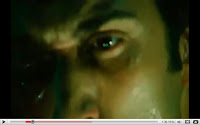
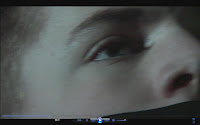


- When our killer begins to get angry and ends up shouting at his victim (1.27 mins) - he manages to compose himself to bring the film back down to slow pace again (helped by the rise and fall in the musics dynamics).
Other aspects we focused on to meet expectations of horror fans:
- Cinematic look with half-dim lighting in a pitch black room, added to by use of blue gel to create a blue tint (right) unique to our film (similar to use of neon green in 'Saw II' - left).
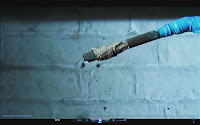
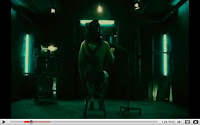
- A confusing montage of the victim waking up at the beginning (0.20-0.30 mins & below) unnerves the audience by disturbing the time period (similar to scene used in 'Hostel').
- Scrawly disorganised font on the credits and title (right) add to the confusion, being a bit like messy handwriting as if the person writing them is in pain. It is unsettling how the titles appear almost randomly throughout the sequence in different sizes, and how the title at the end fades in with each letter appearing at different times in no order at all. It created a mysterious code-cracking effect, as if you had to work hard to realise what the title said and that you may have to look deeper into the film to discover the answers (much like the titles in 'Cloverfield (Reeves, 2008)' (left - best picture I could find) are crackled such as on a fuzzy TV set, representing how the film is more meaningful than it looks and you have to search deep for clues [e.g. the last shot of New York which is set in the past before the whole story happened, a faint line can be seen falling into the sea and this is meant to be how the alien reached earth before the film started] because it is artistic.
- Low-key lighting (right) added to by the flickering lights. We filmed with 3 fairly dim studio lights to highlight shadows in all areas of the characters much like the characters in this particular scene in 'Sin City (Miller & Rodriquez, 2005)' (left) This highlights the expressions of the characters in a particular deep and meaningful scene such as our opening sequence - it is an important part of the story.
- Realistic atmosphere created by added on sounds (diegetic) such as lighting buzz (0.05-0.08 mins) and dripping water (0.15-0.18), giving our film a new dimension - a "spotlight" kind of effect where every little bit of action stood out and was detailed - bringing the audience into the world of the film (e.g. the amplified dripping water and ringing telephone in 'The Ring' (Verbinski, 2002)) [all added on sounds from http://www.soundsnap.com/].
- Use of moody music (non-diegetic) to create a tense atmosphere beyond the reality of the film [music called 'The Platform' from http://www.freeplaymusic.com/].


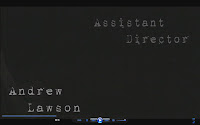

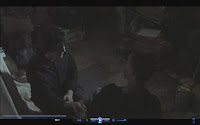
- An intriguing plot carrying a hotel-theme and a well-mannered killer. Enthusiasts would want to know why he is acting this way and what the hotel-theme represents. Our film has a carefully written script, giving the audience subtle hints and clues (e.g. "would you like a glass of water?" said by the killer in a hotel-host kind of way.
- The title helps promote this plot and stir interest. 'Reservation' refers to a hotel reservation. However, I believe it could have been far more effective if it had been called 'The Guests', which is much more to the point and possibly sinister if not easier to remember. Reservation is too long and has too many meanings, making it not mean much at all to the audience in terms of the plot.
- Plenty of enigma codes because of heldback information (this links to the point about the pace of the film), raising questions within the audience and making them want to watch more. The ending to our sequence poses such questions as to whose limbs the hand and foot were and how these victims got there (see 1.50 & 2.00 mins). There is loads of information still to find out (character details such as names are not known at all yet).
- We made our opening scene very intimate with the tight claustrophobic location of the basement (low ceilings and not much space) and the expressions of characters were highlighted by low-key lighting. A combination of good script-writing and excellent acting made the dialogue scene very intense. The audience would immediately feel sorry for our victim as he seems innocent (he is a lot smaller than the killer and is almost being bullied) and the humiliation and tease of this victim seem unnecessary. All the audience can see of the killer is evil as they do not know about his past and just think he is getting a "kick" out of torturing and killing people. Our scene plugs into the audiences emotional pleasures as they are on a characters side and may begin to care for the safety of this character. In scenes where the killer is particularly evil just provokes more of this responce to the film, with emotions such as sadness, anger, sympathy and desperation (we feel these emotions watching films such as 'Saw' as we capture the intense desperation of the characters in their situations due to the realims). The audience are helpless to do anything and may forget the character is fictional.
- Emotional pleasures can lead to visceral pleasures, which are the stimulated physical reactions of the audience to our film. Our opening sequence could provoke many, with sadness causing tears, wittyness causing laughter and anger causing people to tense up. Other than these emotions, the actual sequence itself is stop-starty and up and down a bit like a 'rollercoaster ride'. The pace quickens and slows with the music and the anticipation is high to go with the shocks that make people jump and the twists that make people admire the film in a physical way (i.e. shaking their head in disbelief or crying out). The most common physical reaction to emerge from watching our sequence is a sense of revulsion to what the killer is implying subtly and how he strokes the crow-bar. People cringe thinking about what might happen to the victim as you can faintly see the weapons lined up in the background. The audience are scared the film will become gory and they might often feel the pain (as you do watching 'Hostel' because it is horribly realistic). From our sequence, the gag being ripped off (0.45 mins) could cause someone to jump back or scream out in pain, and the thought of gore and death can cause a nauseous feeling.
- The enigma codes in our film provide the audience with something to solve so anyone can predict what might happen and try and link the important information together to find out what is going on (such as in 'Psycho', we try and guess who is commiting the murders). Solving something can give a sense of pleasure and not being able to know something can frustrate the audience until the end of the film when they find out.
- There is a counter-culture attraction stemming from our film as we release the audience from all rules and regulations. Our opening scene is private, away from authorities, and the killer has complete control. He can do whatever he wants and there are no limits (such as Michael Myers's unlimited power and freedom in 'Halloween'). Our audience get to feel a pleasure from the feeling they have broken rules by watching extreme situations such as our capturing scene.
- A sense of claustrophobia, being trapped or captured.
- Voyerism and the idea of being constantly watched or monitored.
- A sense of being alone in a situation in which you have to try and save yourself with your own thinking - nobody else knows where you are.
- Sense of darkness and night time and being stuck in a creepy-looking location.
- Being surrounded by strangers and bodies.
- Fear of the unknown, what is happening to the victim?
- Fear of the anger of someone you don't know and cannot reason with.
- Fear of unbelievable pain that you cannot defend.
- The fear of death and never being able to see loved ones again.
We applied all these audience factors to our sequence and every decision made that I discussed in this question was made for a reason. It is hard to sum it all up in one question so I tried explaining some thing in detail and others in less detail, but they were all meaningful to appealling to our audience. Whether they were successful or not was down to our audience feedback.
After having an audience screening in front of thirty 17-18's we were able to summarise their opinions and criticisms. It was successful feedback with 11 sample questionnaires (many who had a particular interest in horror) all stating that they enjoyed our sequence and thought it was attractive, so our attention to detail in image and style were helpful. Good points for the film were its clear narrative, depth in the killer's character, scariness of the killer's acting and the shock of the hand at the end. This was very pleasing with both dramatic parts being effective on the audience and making them react (everybody in the room jumped at the shock-ending). The holding back of the pace must have worked to amplify the jumpy moments. There was some constructive criticism; not everybody liked the lights flickering because regular intervals of darkness remained distracting (right). This is something we had thought about before but could not eradicate after shooting. People also had their reservations on the title, which I discussed earlier in this question. The last critical comments were mainly on our victims's acting when the gag was pulled off (0.45 mins) and that this could have seemed more painful and shocking (left). This was a hard shot to film as the gag kept coming off for certain reasons, so we understand how this moment seemed particularly flat at the time. I believe our groups attempts to appeal to this type of audience was very successful (most people stating their desire to continue watching). This was also evident in feedback I recieved elsewhere with my brother and cousin (both between 18-25 years old) getting a feel for the film and being more involved in possible improvements, whereas as 40 year olds like my mum were confused by the plot and dazzled by the lights - so did not get the modern horror genre so much.
Tuesday, January 27, 2009
In Question 3 I discussed how our film opening would be distributed in cinemas so on answering this question this has to be takin into account.

Obviously our main audience will be the horror enthusiasts and especially fans of the 'Saw' and 'Hostel' films, who were likely to share a similar core audience. I tried to find statistical evidence of this but I found this difficult. Instead I managed to find this quote by Tom Ortenberg (see pictures below) - Lions Gate, President of Releasing (upon releasing Saw II):

"We were confident going into this weekend as the only new horror release that we would hit our target audience of genre fans, but this has exceeded all our expectations. With 'Saw,' James Wan and Leigh Whannell have tapped into filmgoers' most base fears and have created something that people immediately feel they need to talk about with others, and see again to catch clues they may have missed the first time."
Tom mentions the target audience of genre fans, meaning the fans particularly of the "gore" subgenre and many classic horror fans interested in the spread of niche modern horror. He also mentions how the film tapped into the audiences worst fears, which I believe ours does (trapped situation, claustrophobia, torture weapons, death and blood) - so our film would maintain a similar appeal, especially to the adrenalin "junkies" and thrill-seekers out there, but also to those with any interest in the genre. Our film (sequence) could basically attract any age if they share these interests, but is important to focus specifically on the 18-25 group who endulge most in cinema entertainment, and for a film it is cinema audience ratings that matter most in its success. Our wider or secondary audience would definately stretch out beyond this small cluster of ages as there are many horror fans over 25 (considering the horror genre originates from the Sir Alfred Hitchcock Period in the 50's and 'Psycho' was produced in 1960 - youngsters from this era will now be in their 60's so some are certainly going to share an interest in how horror has developed).
Gender-wise, our core audience would involve both because of the following points:
- Teenagers and young adults often hang around in mixed gender groups (cinema visits can be a frequent occurance for these groups).
- Horror maintains a strong appeal for couples, especially young couples, on a date (the frights give them a good reason to cuddle and get closer to one another early in the date).
- The film sequence could be seen as male-orientated, in that the actors involved are men and the film involves alot of "masculine traits" - however this is just a generalisation.
- 'The female gaze', derived from Laura Mulvey's 'male gaze' theory (http://en.wikipedia.org/wiki/Gaze), states that although females provoke the gazes of men because of their bodies, males can provoke the gazes of women if they are involved in a private environment as it creates a sexual kind of atmosphere. This can cause females to be attracted to male actors in films (our opening sequence could create this atmosphere as it is private and intimate), and this is a natural reaction (known as scopohilia in medical terms) so is likely to work well. [Scopophiliais the sexual interest in or practice of spying on people engaged in intimate behaviors, such as undressing, sexual activity, or other activity usually considered to be of a private nature - http://www.dictionary.com/]
Overall, there is appeal for both genders and all ages, as long as they hold an interest in the horror genre (or even if they are with people who enjoy horror). Our film would target a core audience of 18-25's (the cinema-goers) and fans of the gore and torture sugenres (or modern horror in general). The mass of this audience would be national (although local to London, our home city, to begin with - see question 3) because of main distribution in the UK.
Monday, January 26, 2009
If it were treated like an amateur film (such as it is) then it could be entered into a student film festival such as Exposures:
http://www.exposuresfilmfestival.co.uk/.
This is the UK's largest festival of film and image work. However, our project would likely do alot better in a less profile festival such as a competition. There are plenty of these around (for example, last year's Orange 60 Seconds of Fame sponsored by Bafta). However, sometimes these require regulations we cannot fit (for example, our film is two minutes, not one). The most likely distributor of our amateur film would probably be an institution specialist to horror. Here is a low-profile film festival I found in the US, dedicated to horror films:
http://www.britfilms.com/festivals/browse/?id=042A214607a4929CEDnPtJ8CF234.
Something like this in Britian would be ideal, especially one dedicated to modern niche horror. The best one I could find was this film festival in Nottingham held over Halloween week in a special arts centre, screening hundreds of student horror films:
http://www.mayhemhorrorfest.co.uk/festival.html.
This seems ideal for our piece, Reservation.
Example of a poster for a film festival - Eerie Horror Fest 2007:

Thinking about our film as a real film in the real film world, it would be distributed by bigger institutions. Our actors are unknowns and not "stars" - actors used to sell a movie as a blockbuster (e.g. Brad Pitt). We chose our actors as to not distract viewers from the story because if was the killer he would be known as Johnny Depp and not as a messed up individual character with depth ('Michael Myers' in 'Halloween' was not a well known actor but became a classic horror character, which was more our intention). Our film would not get the publicity of a blockbuster but I believe it has the potential to be shown in a normal mulitplex cinema.
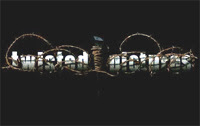 ience. It has unique selling poin
ience. It has unique selling poin ts such as the artistic blue tint and unique storyline breaking conventions. It also has many similarities to real films (this trailer of 'Hostel' being close to how our film would be advertised:
ts such as the artistic blue tint and unique storyline breaking conventions. It also has many similarities to real films (this trailer of 'Hostel' being close to how our film would be advertised:http://uk.youtube.com/watch?v=JBxOjTaUpFM).
'Saw' was extremely successful as it firstly appealed to horror enthusiasts before it became a huge film brand ('Saw V' recieved the highest box-office ratings this Autumn in Britain, 2008). There is no reason why our film could not enjoy success in big cinemas such as Cineworld and The Odeon, as it would benefit from past successes in the subgenre, and would offer a new exciting approach for the horror lovers of the cinema.

To get our film into the cinemas we would need to link up with a distributor to sell our film to the big cinemas (the cinemas are owned by the exhibitor companies, who show the films). 'Lions Gate UK' is part of 'Lions Gate Films' who distributes in the UK, so we could have a good link there. We would not be likely to gain the services of a big distributor such as 'Universal' but could target smaller ones such as 'Revolver Entertainment' who do specifically thrillers or 'Tartan films' who have distributed low-budget horror films such as 'Black Christmas (Morgan, 2006)'.

The distributer could firstly distribute to cinemas in London and see how viewings are for a week. The results of this would control whether we began distributing to other regions in the South and then into the North. A good advertising campaing and strong word of mouth could help profoundly. Lastly, we could promote our films in targeted countries such as Japan who are renowned for horror-making. The more successful our film is in these countries the closer we could come to releasing across the rest of Europe and even in America. Global success would be unlikely for the first film release by the production and film company, but the potential could possibly be enhanced by solid advertising and good links with other companies.
To summarise, as an amateur film ours would be screened at a student film festival specifically for low-budget horror films in the UK. This could be shown in a special arts cinema. As a real film, our production and film companies could link up with bigger companies of similar genres to add finance backing and increase the potential of people our film could reach by good promotion and advertising. It would be distibuted by a distributo specific to horror and fairly cheap. The success of the film would depend on how far it would spread across the country and globally - and also if the film would be released on DVD after with the help of a platform converter company (from cine to DVD). With a good distribution strategy and relations between bigger institutions our film would have the potential to challenge the successes of the likes of 'Saw' and 'Hostel'.






























